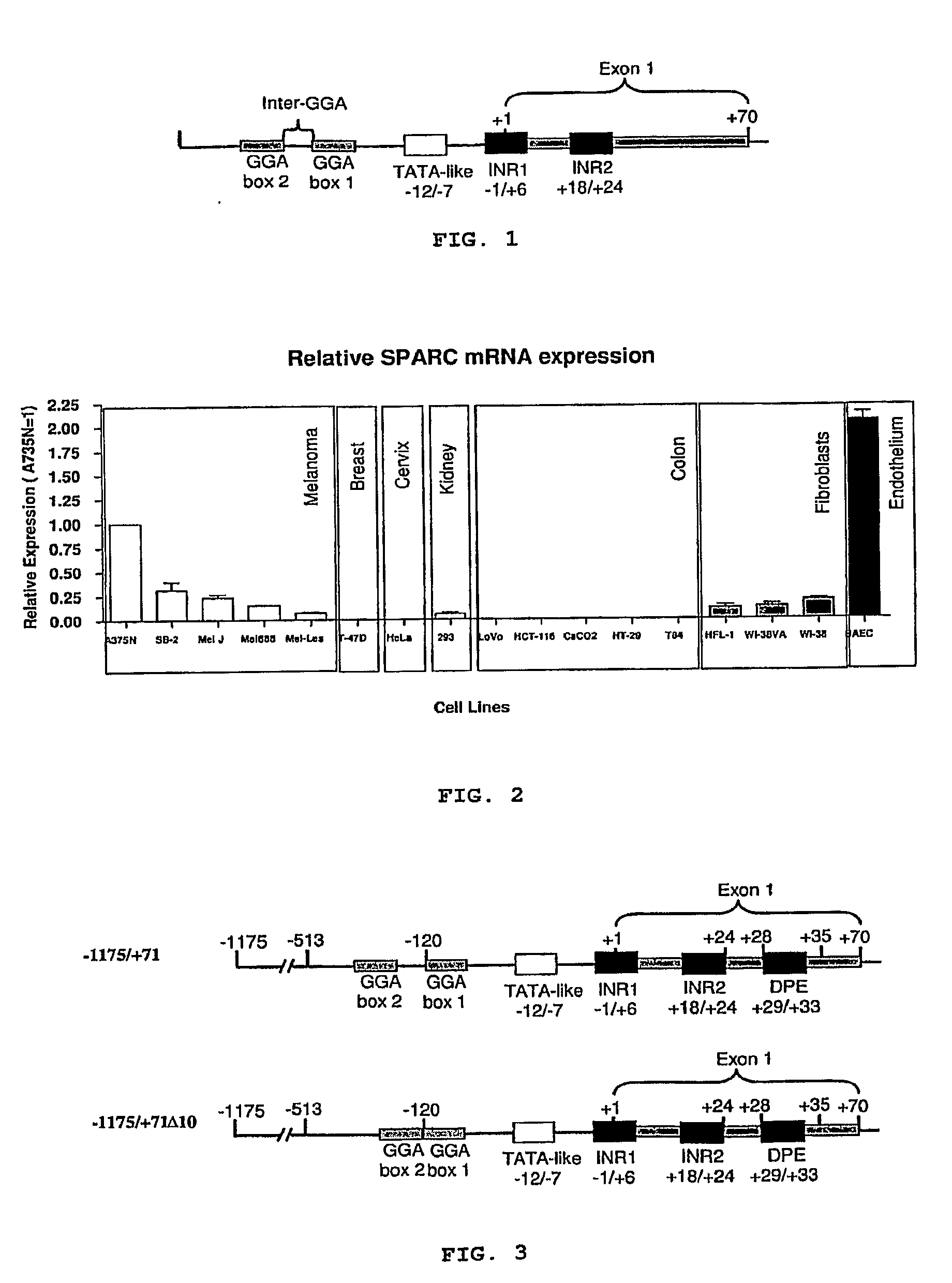Isolated DNA fragment of the sparc human promoter and its use for driving the expression of an heterologous gene in tumor cells
a human promoter and heterologous gene technology, applied in the field of gene therapy, can solve the problems of low in vivo transduction capacity and inability to achieve the same results when used
- Summary
- Abstract
- Description
- Claims
- Application Information
AI Technical Summary
Benefits of technology
Problems solved by technology
Method used
Image
Examples
example 1
Evaluation of the Expression of SPARC mRNA in Different Tumor and Normal Lines
[0059]The levels of produced messenger RNA (mRNA) from the SPARC protein were assessed by Real-Time PCR in tumor cell lines and normal cell lines.
[0060]The human lines HeLa (cervix cancer, ATCC No. CCL-2), T-47D (breast cancer, ATCC No. HTB-133), WI-38 (fetal pulmonary fibroblasts, ATCC No. CCL-75), WI-38 VA (transformed fetal pulmonary fibroblasts, ATCC No. CCL-75.l), HFL-1 (fibroblasts, ATCC No. CCL-153), 293 (embryo kidney, ATCC No. CRL-1573), LoVo (colon cancer, ATCC No. CCL-229), HCT-116 (colon cancer, ATCC No. CCL-247), CaCO2 (colon cancer, ATCC No. HTB-37), HT-29 (colon cancer, ATCC No. HTB-38), T84 (colon cancer, ATCC No. CCL-248) and aortic endothelial cells (Bovine Aortic Endothelial Cells, BAEC ATCC No. CRL1395) were obtained from ATCC (American Tissue Culture Collection, Rockville, Md., USA). The human melanoma cell lines IIB-MEL-LES and IIB-MEL-J-N were previously described by Ledda et. al., 1...
example 2
Cloning of 11 Fragments of the Human SPARC Promoter in the PGEM and TOPO Plasmids
[0063]A sequence analysis of the human SPARC promoter performed by the present inventors revealed a DPE sequence (Downstream Promoter Elements) present between the bases +29 / +33 as well as the 2 possible transcription initiation sites which had already been described, INR1 and INR2 (see above cited FIG. 1). The DPE sequence was described in Drosophila promoters and is considered to have a role in the transcriptosome assembly in those promoters not containing TATA sequences (Kadonaga, J. T. The DPE, a core promoter element for transcription by RNA polymerase II. Exp Mol Med, 34: 259-264, 2002). As a result of this analysis, present inventors carried out a directed mutation of the promoter. For that purpose, they worked on the 5′ ends: −1175 (for cloning the complete promoter), −513 (by analogy with the bovine promoter) and −120 (which includes exactly the GGA1 sequence). The 3′ end mutations include the ...
example 3a
Selection of a Fragment of the Human SPARC Promoter
[0078]The promoters obtained according to Example 2 were subcloned in the MluI / BglII, MluI / XhoI or NheI / XhoI sites of the pGL3-Basic plasmid (Promega Corp., Madison, Wis., USA) upstream of the luciferase reporter gene. All of the clonings was confirmed by restriction profiles and by sequencing the vectors (pGEM, TOPO and / or pGL3) with the universal primers T7 (TACGACTCACTATAGGG; SEQ ID NO 27); Sp6 (ATTTAGGTGACACTATAG; SEQ ID NO 28), T3 (ATTAACCCTCACTAAAGGGA; SEQ ID NO 29) or P2 (CTTTATGTTTTTGGCGTCTTCCA; SEQ ID NO 30) and P3 (CTAGCAAAATAGGCTGTCCCC; SEQ ID NO 31).
[0079]The pGL3-Basic plasmid contains the modified Firefly luciferase reporter gene (luc+) for preventing the binding of genic regulatory factors, removing the restriction sites, preventing the protein transport to peroxisomas and it contains a Kozak sequence in the 5′ end of the luciferase gene for optimizing the translation efficiency.
[0080]The presence of the luciferase re...
PUM
| Property | Measurement | Unit |
|---|---|---|
| Composition | aaaaa | aaaaa |
| Responsivity | aaaaa | aaaaa |
Abstract
Description
Claims
Application Information
 Login to View More
Login to View More - R&D
- Intellectual Property
- Life Sciences
- Materials
- Tech Scout
- Unparalleled Data Quality
- Higher Quality Content
- 60% Fewer Hallucinations
Browse by: Latest US Patents, China's latest patents, Technical Efficacy Thesaurus, Application Domain, Technology Topic, Popular Technical Reports.
© 2025 PatSnap. All rights reserved.Legal|Privacy policy|Modern Slavery Act Transparency Statement|Sitemap|About US| Contact US: help@patsnap.com



